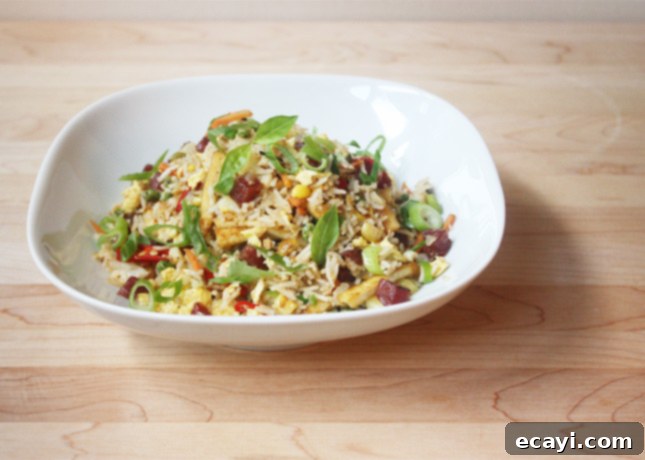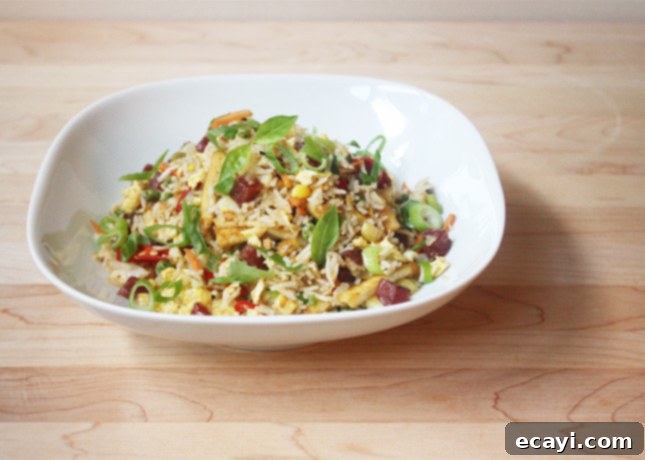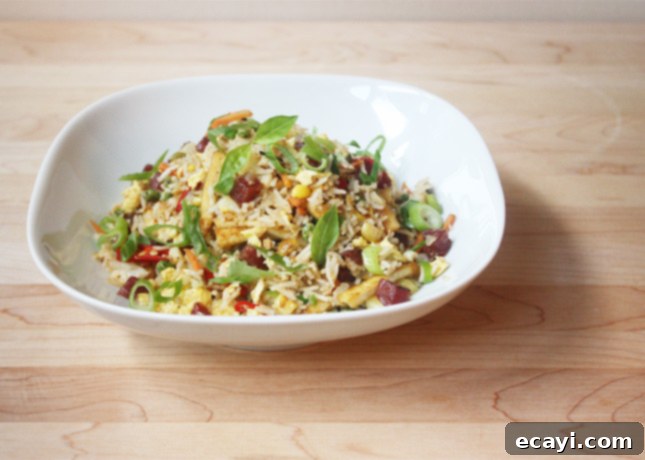Mastering Healthy Homemade Fried Rice: A Flavorful & Veggie-Packed Guide
Forget takeout and discover the joy of crafting your own homemade fried rice! This comprehensive guide reveals a simple yet effective formula to create a delicious, healthier, and vibrantly veggie-filled dish that will impress everyone at your table. It’s a culinary adventure that transforms everyday ingredients into an outstanding meal.

This post contains affiliate links. Full disclosure is at the bottom of the article.
You might be wondering, “Do I really need a recipe for homemade fried rice?” After all, many of us typically whip up fried rice as a quick way to use up leftovers: stir-fry some vegetables, toss in rice, add a few seasonings, crack an egg, and call it a day. While this impromptu approach can certainly yield a decent last-minute snack, mastering the specific techniques and understanding the core principles behind a truly great fried rice will elevate your dish from merely acceptable to absolutely outstanding. This isn’t just about throwing ingredients into a pan; it’s about following a proven method that guarantees a flavorful, perfectly textured, and incredibly satisfying meal every single time.
Why Choose Homemade Fried Rice?
There are countless reasons to make fried rice at home. Firstly, it offers unparalleled control over ingredients. You can select fresh, high-quality vegetables, lean proteins, and adjust seasonings to your exact preference, making it significantly healthier than many restaurant versions. Secondly, it’s a fantastic way to minimize food waste by utilizing leftover rice and any vegetables lingering in your fridge. Finally, the process itself is surprisingly quick and rewarding, transforming simple components into a complex and delicious dish in under 30 minutes once your ingredients are prepped.
The Secret Formula for Outstanding, Healthier, Veggie-Filled Homemade Fried Rice
My formula isn’t complicated, but it focuses on key elements that make all the difference. By paying attention to these four pillars, you’ll unlock the full potential of this beloved Asian-inspired dish:
1. Start with the Right Rice: Cold and Cooked
The foundation of any great fried rice is, naturally, the rice itself. And the most crucial rule? It must be **cold and already cooked**. Leftover rice is ideal for this purpose, as the grains have had time to dry out and firm up in the refrigerator. This drying process is vital because it prevents the rice from clumping together and becoming mushy when stir-fried. Instead, each grain separates beautifully, allowing it to toast and crisp slightly in the hot wok or skillet, absorbing all the wonderful flavors without turning soggy.
For the best texture and flavor, I recommend using a medium-grain rice like jasmine or a long-grain rice such as basmati. Their distinct aromas and textures hold up well to the stir-frying process. If you don’t have leftover rice, don’t despair! Simply cook a fresh batch, then spread it thinly on a baking sheet immediately after it’s done. Place it in the freezer for about 15-20 minutes, or in the refrigerator for an hour or two, until it’s completely cooled and dry to the touch. This step is non-negotiable for achieving that coveted, perfectly fried texture.
2. Abundance of Vegetables for Color, Flavor, and Nutrition
While fried rice sometimes gets a bad rap for not being the healthiest dish, its nutritional profile is entirely dependent on what you choose to incorporate. My secret to making it both delicious and healthy is simple: **load it with vegetables!** I aim for at least half as much vegetables as rice, ensuring that every spoonful is bursting with color, texture, and a wealth of nutrients. This approach not only boosts the fiber and vitamin content but also adds incredible depth of flavor and visual appeal.
Think beyond just a few peas and carrots. Seasonal vegetables are always a great choice, allowing you to experiment with different flavor combinations throughout the year. Consider a vibrant medley of cauliflower florets, matchstick carrots, sweet corn kernels, and tender green peas, as suggested in the recipe below. But don’t stop there! Snow peas, green beans, diced bell peppers, mushrooms, broccoli florets, edamame, and shredded cabbage are all fantastic additions. Pre-cut your vegetables into uniform, bite-sized pieces to ensure even cooking and a consistent texture in your finished dish.
3. Dynamic Flavorings: The Heart of the Dish
The right combination of flavorings is what truly transforms simple rice and vegetables into an extraordinary meal. The classic trio of **onion, garlic, and ginger** forms the aromatic backbone of most fried rice recipes, providing a pungent, spicy, and warming base. I also love to introduce a subtle kick with sliced fresh chilies – choose a mild variety or deseed them if you prefer less heat. As a finishing touch, fresh herbs like basil or cilantro add a burst of freshness that brightens the entire dish.
For the sauces, I’ve evolved my approach over time. While soy sauce is a traditional and perfectly acceptable choice, I’ve recently discovered a preference for a combination of **fish sauce and rice wine vinegar**. This pairing introduces an incredibly complex umami depth that’s both savory and tangy, enhancing the natural flavors of the other ingredients without adding a dark color to the rice, which soy sauce typically does. This allows the vibrant colors of your vegetables to truly shine through. Experiment with these sauces to find your personal favorite, adjusting to taste to strike the perfect balance of savory, sweet, and tangy notes.
4. Quality Proteins for Substance and Satiety
Proteins are essential for making your homemade fried rice a complete and satisfying meal. Eggs are, of course, a quintessential staple, adding richness and a wonderful soft texture. However, if you want to truly elevate your fried rice to the next level, I highly recommend incorporating **Chinese sausage (lap cheong)**. If you’ve never tried it, you are in for a treat! It has a unique sweet-savory flavor profile and a distinct chewy texture that is incredibly addictive and unlike any other sausage you’ll encounter. You can typically find it in Asian grocery stores, often in the dried goods or freezer section.
If Chinese sausage isn’t available, diced bacon is an excellent substitute, offering a similar salty, savory richness. For a vegetarian option, you can omit the sausage entirely, or enhance the protein content with extra firm tofu, as I often do. Tofu adds a fantastic nutritional boost and makes the dish even more filling and substantial. You can also experiment with other proteins like diced chicken, shrimp, thinly sliced pork, or even beef to customize your fried rice to your liking.
Essential Tips for Successful Stir-Frying
Beyond the core formula, a few key techniques will ensure your fried rice turns out perfectly every time:
- Mise en Place is Key: “Mise en place” means “everything in its place.” Chop all your vegetables, mince your aromatics, measure out your sauces, and beat your eggs *before* you even turn on the heat. Stir-frying is a very fast cooking method, and you won’t have time to chop as you go.
- High Heat: Use a wok or a large, heavy-bottomed nonstick skillet over high heat. This creates the “wok hei” (breath of the wok) – that distinct smoky, charred flavor characteristic of truly authentic fried rice.
- Don’t Overcrowd the Pan: Cook ingredients in batches if necessary, especially if you’re making a larger quantity. Overcrowding will lower the temperature of your pan, steaming your ingredients instead of frying them, which can lead to soggy results.
- Scrambled Eggs First: Cook the beaten eggs quickly until just set, then remove them from the wok. This prevents them from overcooking and becoming rubbery when added back in later.
- Season in Layers: Add salt and other seasonings at different stages to build complexity. Remember that fish sauce (or soy sauce) also contributes saltiness, so adjust accordingly.
This healthier, veggie-filled homemade fried rice typically takes only 10-15 minutes to cook, provided all your prep work is done before you heat your wok. It has quickly become one of our family’s favorite go-to meals. Each time I make it, it feels like a fresh culinary experience because I love to vary the vegetable combinations based on what’s in season or what I have on hand. I encourage you to try this recipe at home; I bet it will swiftly become a beloved staple in your kitchen too!

Pin Recipe
Healthier, Veggie-Filled Homemade Fried Rice
Ingredients
- 4 tbsp 60 ml peanut or canola oil, divided
- 3 eggs beaten
Proteins:
- 3 links Chinese Sausage lap chang, cut in 1/4-in (0.5-cm) dice
- 1/2 cup 125 ml firm or extra-firm tofu, diced
Aromatics:
- 2 inches 5 cm fresh ginger, finely grated
- 1 small onion finely chopped
- 2 cloves garlic finely minced
- 2 long red chilies sliced (these chilies are fairly mild, but remove the seeds if you don’t like things spicy)
Veggies:
- 1/2 cup 125 ml each, for a total of 2 cups (500 ml) vegetables (see note)
- 1/2 cup 125 ml cauliflower, cut in small florets
- 1/2 cup 125 ml carrot, matchsticks
- 1/2 cup 125 ml corn kernels (fresh or frozen)
- 1/2 cup 125 ml green peas (fresh or frozen)
- 4 cups 1 L cooked rice, cold
- 1 tsp 5 ml kosher salt, or to taste
Seasonings:
- 1 tbsp 15 ml fish sauce, or to taste
- 2 tbsp 30 ml rice wine vinegar
- 3 green onions white and green parts, thinly sliced
- Fresh basil to serve
Instructions
Helpful tip: Make sure all your ingredients are prepped and ready before you start frying.
-
Cook the egg: Heat 1 tbsp (15 ml) canola oil in a wok or a large nonstick skillet over medium-high heat. When it’s hot, pour in the beaten eggs and stir constantly until puffed and cooked. Remove from the wok and set aside for later. Wipe out or clean the wok.
-
Cook the vegetables: Heat 1 tbsp (15 ml) canola oil the wok over high heat until it’s shimmering. Add the 2 cups vegetables (cauliflower to green peas) and season with a pinch of kosher salt. Stir-fry until the vegetables are crisp-tender, about 5 minutes. Remove from the pan and set aside with the eggs. Wipe the wok clean.
-
Cook the proteins: Chinese sausage and tofu are fully cooked, so you only need to heat them. Heat 1 tbsp (15 ml) canola oil to the wok over high heat and add the diced sausage and tofu and sauté until they’re golden and a little crisp. Careful not to overcook the sausage so it doesn’t get dry and tough. Remove the meat (set it aside with the eggs and veggies) and keep any rendered fat in the pan. Note: if you’re using bacon, sauté it for 2-3 minutes before adding the tofu to make sure it’s cooked.
-
Cook the aromatics: Add the remaining 1 tbsp (15 ml) canola oil to the hot wok. When it shimmers, add the onion and sauté until it starts to soften, about 3 minutes. Add the ginger, garlic and chilies and sauté for 2 minutes more.
-
Add the rice: When the ginger and garlic are starting to turn golden, add the rice all at once. Gently poke the rice to separate chunks, tossing it to make sure every grain touches the hot canola oil and the aromatics are well incorporated. Stir-fry until the rice is very hot and looks dry and separate. If you don’t have a really hot burner, it’s ok to let the rice sit for a few seconds at a time before stirring; less agitation is actually better than more as long as nothing is scorching. Season wtih a few pinches of kosher salt, keeping in mind that the fish sauce in the next step will also add saltiness.
-
Mix in all the cooked ingredients and seasonings: Toss in the cooked egg, vegetables, sausage and tofu, and mix well over high heat. Clear a spot in the center of the wok for the wets seasonings. Pour the fish sauce and rice wine vinegar into the wok. Let them become hot and bubbly before stirring the rice into it. Keep cooking and tossing until the rice is dry again.
-
SERVING: Add the sliced green onion. Mix well. Serve each portion very hot, topped with chopped fresh basil.
-
STORAGE: Leftover homemade fried rice will keep refrigerated for a couple of days. I love to reheat it for breakfast! I even like to enjoy it cold, straight out from the fridge, as a snack.
-
Recipe Credit: Adapted from a technique and recipe by Whitney Chen.
Notes
Did you make this?
Tell me how you liked it! Leave a comment or take a picture and tag it with @foodnouveau on Instagram.
We hope this detailed guide empowers you to create the best homemade fried rice you’ve ever tasted. By focusing on quality ingredients, understanding the simple yet powerful formula, and applying these practical tips, you’ll find that a truly exceptional fried rice is not only achievable but also incredibly rewarding. Enjoy the process of cooking and the delight of sharing a delicious, healthy, and satisfying meal with your loved ones!
Disclosure Notice: This site is a participant in the Amazon Associates Program, an affiliate advertising program designed to provide a means for the site to earn fees by linking to Amazon and affiliated sites. When you click on an affiliate link and make a purchase through such links, I may earn advertising or referral fees at no extra cost to you. This valuable support helps me continue to create and share new, delicious content for the blog–so thank you for your support! Learn more about advertising on this site by reading my Disclosure Policy.
